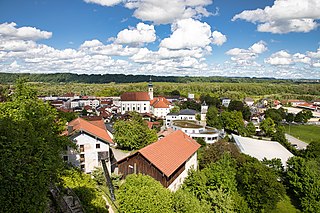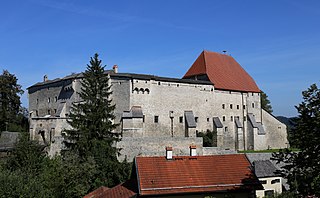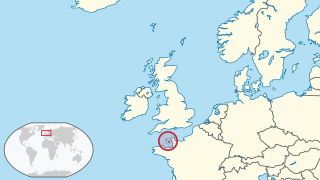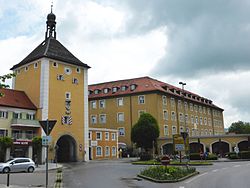
Castle Colditz is a Renaissance castle in the town of Colditz near Leipzig, Dresden and Chemnitz in the state of Saxony in Germany. The castle is between the towns of Hartha and Grimma on a hill spur over the river Zwickauer Mulde, a tributary of the River Elbe. It had the first wildlife park in Germany when, during 1523, the castle park was converted into one of the largest menageries in Europe.

Laufen is a town in Berchtesgadener Land district in Bavaria at the Austria–Germany border.

Tittmoning is a town in the district of Traunstein, in Bavaria, Germany.
Oflag VII-B was a World War II German prisoner-of-war camp for officers (Offizierlager), located in Eichstätt, Bavaria, about 100 km (62 mi) north of Munich.

Oflag X-C was a German World War II prisoner-of-war camp for officers (Offizierlager) in Lübeck in northern Germany. The camp was located on the corner of Friedhofsallee and Vorwerkstrasse, close to Lübeck's border with the town of Schwartau, and is often cited as being located in Schwartau rather than Lübeck.

Oflag VII-D was a World War II German prisoner-of-war camp for officers (Offizierlager) located in Tittmoning Castle in south-eastern Bavaria.
Oflag V-B was a World War II German prisoner-of-war camp for officers (Offizierlager), in operation from 1940 until 1942. It was located in Biberach in south-eastern Baden-Württemberg.
Ilag is an abbreviation of the German word Internierungslager. They were internment camps established by the German Army in World War II to hold Allied civilians, caught in areas that were occupied by the German Army. They included United States citizens caught in Europe by surprise when war was declared in December 1941 and citizens of the British Commonwealth caught in areas engulfed by the Blitzkrieg.
Sir Ambrose James Sherwill was Bailiff of Guernsey from 1946 to 1959. In the early months of World War II, he helped in the administration of the Channel Islands when they were occupied by the Germans.

Numerous internment camps and concentration camps were located in France before, during and after World War II. Beside the camps created during World War I to intern German, Austrian and Ottoman civilian prisoners, the Third Republic (1871–1940) opened various internment camps for the Spanish refugees fleeing the Spanish Civil War (1936–1939). Following the prohibition of the French Communist Party (PCF) by the government of Édouard Daladier, they were used to detain communist political prisoners. The Third Republic also interned German anti-Nazis.

Josef Nassy was an Surinamese American expatriate artist of Jewish descent. Nassy was living in Belgium when World War II began, and was one of about 2,000 civilians holding American passports who were confined in German internment camps during the war.
Captain Kenneth Lockwood was a stockbroker and an officer in the British Army. He was one of the first six British prisoners of war to arrive at Oflag IV-C, Colditz, in 1940. He made and assisted in numerous escape attempts, working with the chairman of the escape committee, Pat Reid, and was still at the castle when it was liberated by the US Army in April 1945. He was the honorary secretary of the Colditz Association for 50 years.
Machiel van den Heuvel was a Dutch army officer. As a prisoner-of-war in Oflag IV-C at Colditz Castle, Germany, during World War II, he served as Escape Officer for the Dutch POWs, a role also held by Captain Pat Reid, the author of The Colditz Story, for the British. Van den Heuvel played a key role in most Dutch officer escapes during the war.
John Robert Edward Hamilton-Baillie MC, was a British Royal Engineers officer famed for numerous escapes from German prisoner of war camps during World War II. During his later life he was a founder of the Fortress Study Group, a prominent member of the Concrete Society, and a dedicated fund raiser for the Red Cross.

Laufen Castle is a square-shaped castle overlooking the Salzach river that was built for the Archbishop of Salzburg in the 15th century. The castle is located in the town of Laufen in the German state of Bavaria. During the Second World War, it was the site of Oflag VII-C, and later of Ilag VII.
John George Lingshaw was a British collaborator who worked in Germany on Nazi propaganda during World War II. In 1946, he was convicted of offences under the Defence Regulations and sentenced to five years penal servitude.

The history of the Jews in Guernsey dates back to well before the events of 1940–5. A London Jew named Abraham was described in 1277 as being from "La Gelnseye" (Guernsey). A converted Portuguese Jew, Edward Brampton, was appointed Governor of Guernsey in 1482.

The history of the Jews in Jersey dates back to at least the 1790s. There was a community in Jersey from the 1840s. The Jersey Old Hebrew Congregation was founded in 1843 and closed around 1870.

On direct instructions from Adolf Hitler, Nazi German forces deported and interned 2,300 Channel Islands civilian residents. The stated reason was retaliation for internment of German citizens in Persia by the British Government.

Nazi Germany operated around 1,000 prisoner-of-war camps during World War II (1939-1945).













